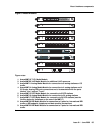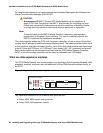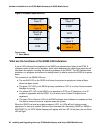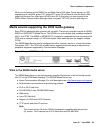
About hardware components
Issue 9.1 June 2006 93
When you first power up the S8300, the red Major Alarm LED lights. During startup, an LED
sequence runs: red ALM, green TST, yellow ACT, green OK-to-Remove, and the three LEDs
under the Services Port, after which all LEDs turn off. At this point, you can connect to the
S8300. When Communication Manager starts, the green TST LED turns on and stays on.
Media servers supporting the G700 media gateway
Each G700 is associated with a primary call controller. The primary controller may be an S8300,
S8500, or S8700/S8710 Media Server. The S8300 is on a circuit pack that is always installed in
slot V1 of a G700. The S8500 or S8700/S8710 is housed in a separate box that connects to the
G700 over a network through a C-LAN circuit pack. Both media servers can support multiple
G700s.
The S8300 Media Servers can be configured as either a primary server or a Local Survivable
Processors (LSP). The G700 with a media server supports the entire range of adjuncts and
peripheral equipment supported by Communication Manager.
Figure 6: Avaya S8300B Media Server
What is the S8300 media server
The S8300 Media Server is an Intel processor complex that mounts in the first media module
slot (V1) of the G700 Media Gateway. The S8300B Media Server has:
● Avaya Communication Manager (For a full description see: http://www.avaya.com/support)
● Administration and maintenance provisioning software
● 20 G or 30 G hard drive
● 512 MB RAM (in two 256 MB DIMM strips)
● Web server
● Linux OS (Red Hat)
● Support of H.248 and H.323 Protocols
● TFTP server and other IP services
Note:
Note: The current version (B) of the S8300 is backward compatible with the previous
(A) version. The A version has a 20 G hard drive and 256 MB RAM.


















